Kabomba: features of an aquarium plant, maintenance and breeding
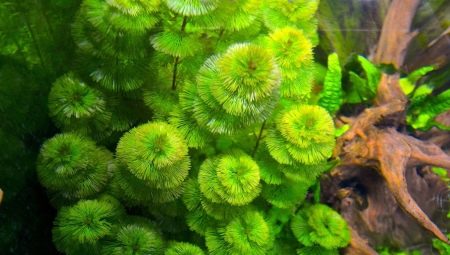
Today, it will be possible to beautifully decorate an aquarium with the inhabitants of the aquatic world with the help of many plants. Among the huge assortment, the kabomba deserves special attention - an aquarium culture presented in a large variety of species.
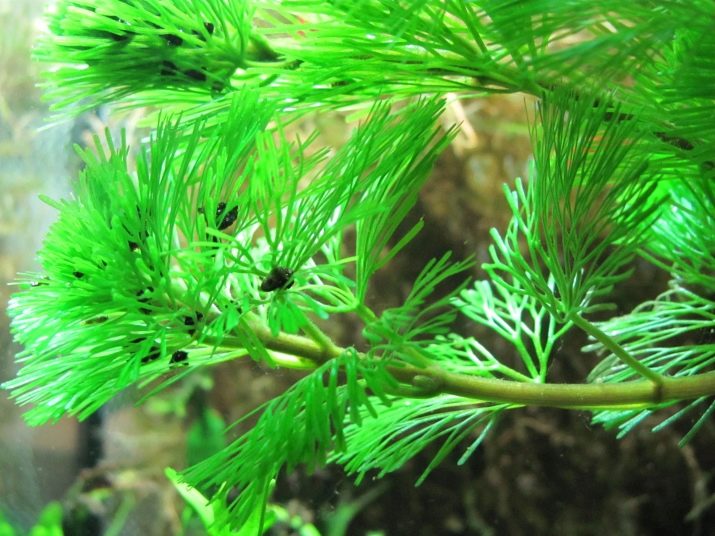
Description
Ferns, mosses, algae, and other aquarium plants are actively used to decorate tanks with and without aquatic life. However, no less popular for such purposes is the kabomba - a plant with dense branches covered with thin, thread-like leaves, which determine its resemblance to needles. Such a culture can have a wide variety of colors, ranging from the usual shades of green to bright red varieties.
The aquarium plant is attractive not only for its shoots and leaves, but also for its ability to bloom, thanks to which the underwater "Christmas tree" becomes even more beautiful, acquiring a festive look.
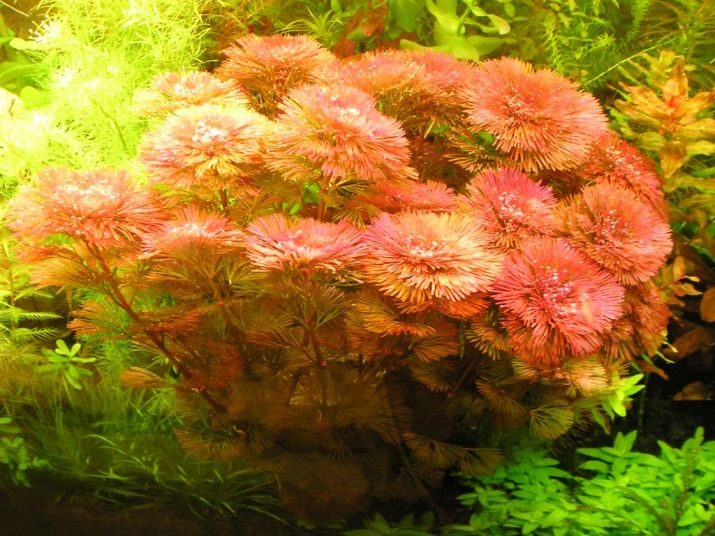
Kabomba belongs to the family of the same name of Kabomba cultures. It is believed that the origins of the plant go back to the countries of South America, Brazil and Guiana.
The culture, unlike mosses, has a creeping root system, creeping stems that first stretch straight up, but then fall under their weight to the bottom and begin to branch out. Leaves grow opposite, do not have stipules, young foliage can have a pale pink or crimson color, later it turns green. They are usually collected in whorls of 3-4 pieces.
As for the shape, the leaves can be whole or with a heart-shaped base, the surface is smooth and shiny. Flowers form on sepals, grow singly, on a long stalk.They can bloom both in water and under water. The flowering phase occurs in the first months of spring. When kept in aquariums, the culture grows well and develops without human intervention.
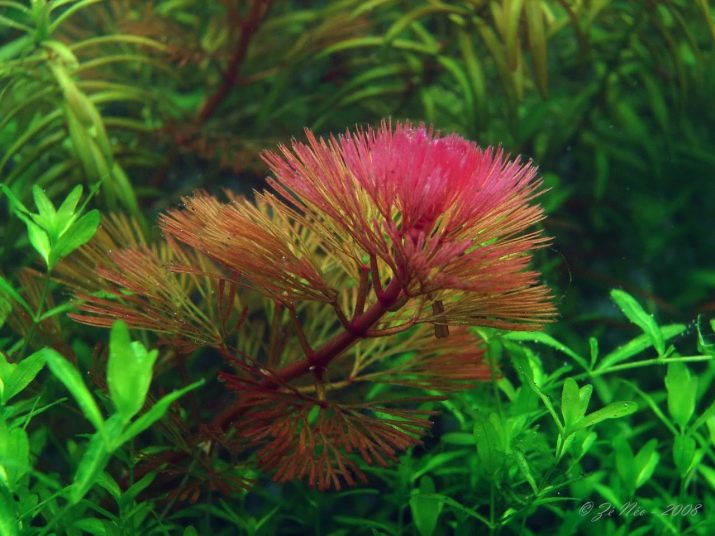
Kabomba is called a truly marsh grass, even when the culture reaches the surface of the water with its shoots, it will not leave it, since the stem must always be in the aquatic environment.
And on the surface, floating leaves can form, separately resembling water lilies.
In addition to its main decorative function, a kabomba in tanks with aquatic inhabitants is capable of performing several more equally significant tasks.
- First of all, this concerns the ability of the plant to activate vital metabolic processes in the aquatic environment. The culture in the phase of its growth and development absorbs nitrates and other harmful compounds, acting as a natural filter in the aquarium.
- The kabomba becomes a complete hiding place for many small fish or crustaceans.
- In addition, in the plant itself, a process important for the aquatic fauna can occur - spawning. In light of this, it performs a very important function for the aquarist and aquatic life.
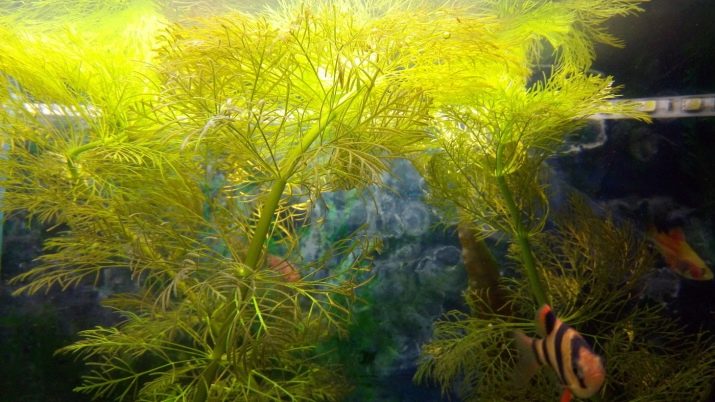
In general, during aquarium breeding, the kabomba does not stand out for any incompatibility with other similar aquatic crops, but in light of the fact that it grows rather quickly in tanks, it can simultaneously oppress and absorb nearby growing plants.
It is this fact that warns against planting grass in the vicinity of especially sensitive varieties of aquarium flora.
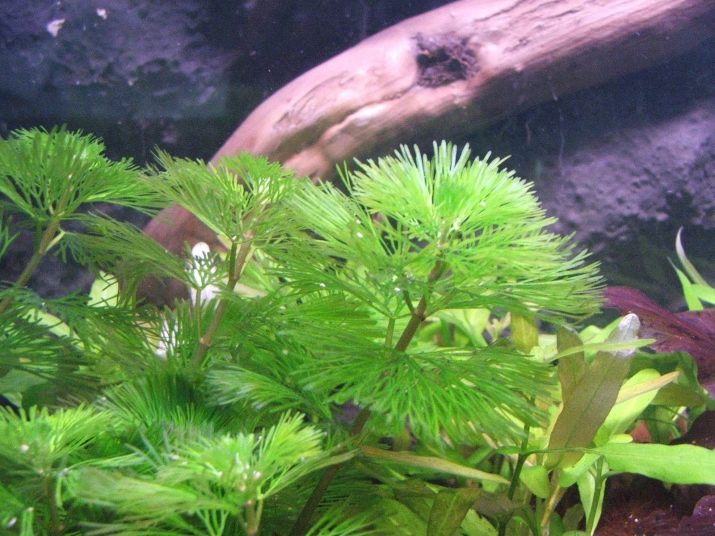
In addition to vegetation, there are recommendations for the joint maintenance of aquatic life and flowering culture. So, too active ornamental fish can harm the leaves of the culture, provoking their premature fall off with their movement. Despite its unpretentiousness and endurance, The kabomba is very sensitive to mechanical damage, so it should be bred in aquariums with calm and medium-sized inhabitants.
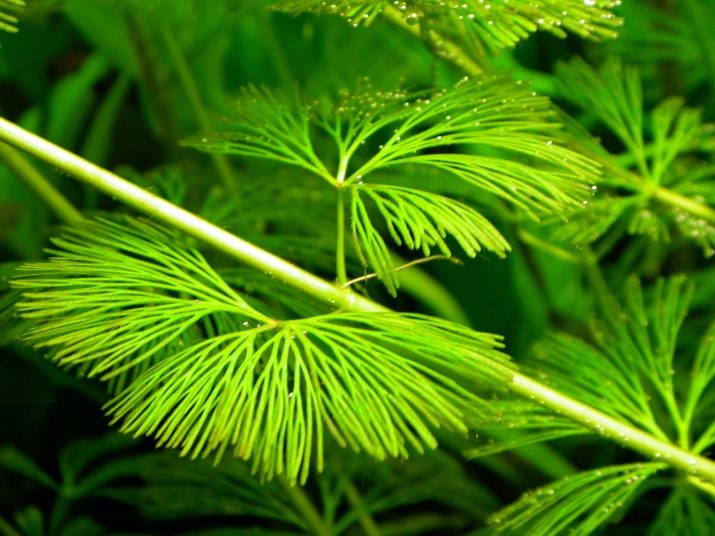
Varieties
Today there are a huge number of varieties of this aquarium culture. Especially popular types of kabomba are worth noting.
Karolinska
A crop with a long, erect stem. Her leaves will be colored green, their width usually does not exceed 5 centimeters. The plant blooms with yellow airy flowers. This species is usually used for background rooting in group compositions.
For a kabomba, the length of daylight hours is important, which should be at least 8 hours. The optimal lighting indicators will be devices with a capacity of 50 lm / l.
The plant should be protected from contact with direct sunlight. Kabomba is kept in water, the temperature of which will be + 22.27 ° C with an acidity of 6 pH. The species can be propagated by cuttings.
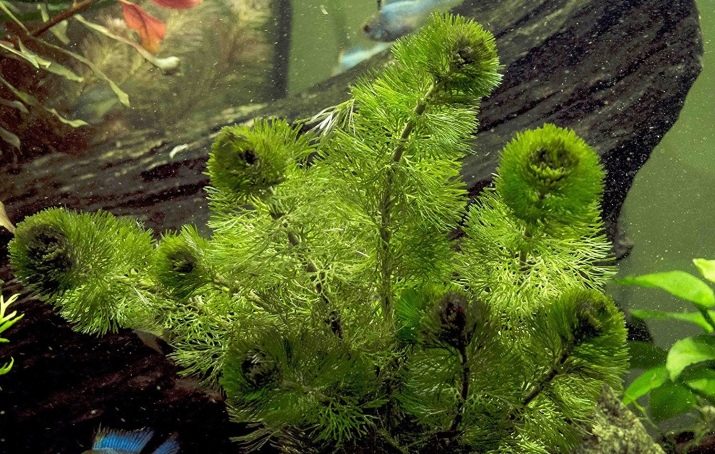
Water
From the creeping rhizome, the stems of the culture are formed. The plant stands out among the rest of the family with a fan-shaped leaf shape. Vegetation color can range from light green to scarlet.
This variant of the aquarium culture is suitable for rooting in the middle of the tank, and it propagates by cuttings.
For the proper development of the aquatic kabomba, you will need liquid. with a temperature of at least + 24 ° C at a level of illumination of the tank in the range of 50-70 Lm / l, as well as a hardness at 6 pH.
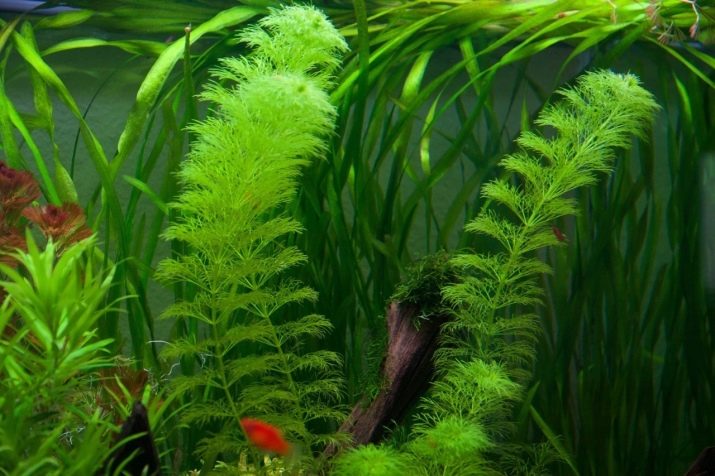
Forked
Among the available varieties, this particular species is considered the most attractive. The leaf blade of the culture is usually colored red-yellow, while the petals at the corolla will be purple with yellow blotches at the base. The culture grows in aquariums up to 40 centimeters, suitable for placement in a tank in the background. Contained at a lighting level in the range of 0.7 to 1 W / L at a temperature of + 24 ° C. In order for the plant to develop correctly, it will need fertilizing in the form of micronutrient fertilizers.
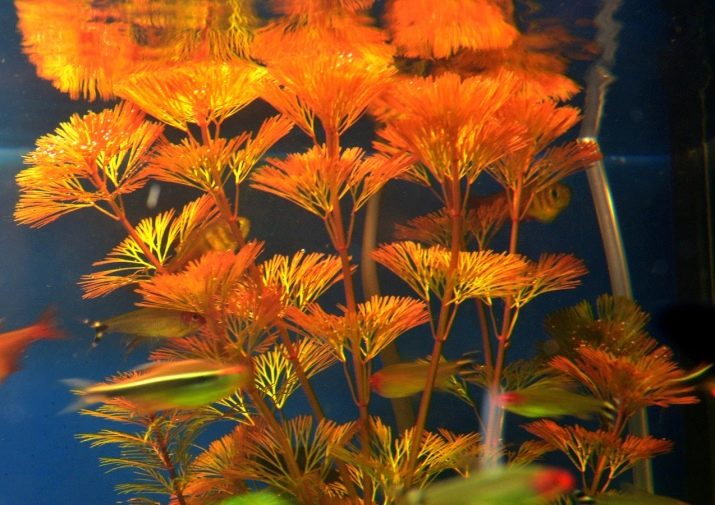
Spiral-leaved
The foliage of the culture has a characteristic silvery tint, the similarity with needles in the described species is special, since each leaf has a dissection.
The aquarium culture reaches a height of about 25-30 centimeters. It is usually rooted along the back of aquariums.
In order for the kabomba to delight with its attractiveness, it will need to provide 12-hour daylight hours, as well as a water temperature of at least + 24 ° C.
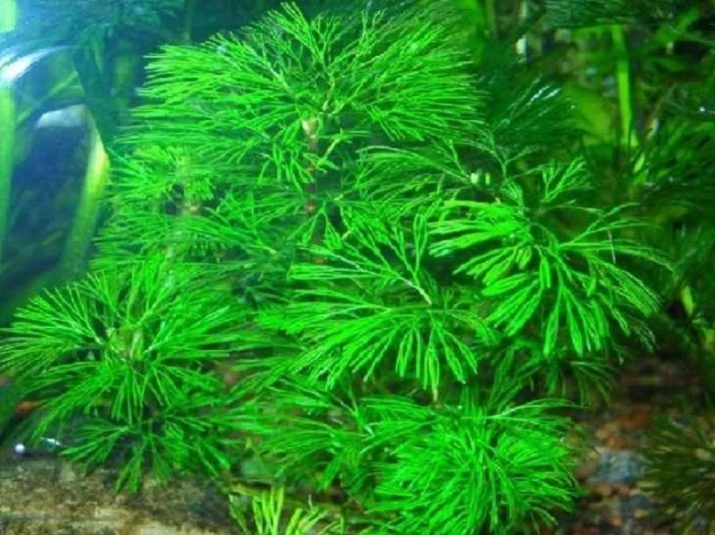
Fairest
The stems of the plant are not prone to strong branching, the shoots are reddish in color. When the kabomba reaches the surface of the water in height, floating foliage will form on it, located in the opposite form. The foliage of the culture develops with a petiole, its color can vary from reddish to green.
The shape of the leaves is solid, as a rule, their size does not exceed 4 centimeters.
This species looks very beautiful in group plantings, it is best to plant it near the back wall. To maintain a culture, it is not required to create any unique conditions - the only requirement is to protect it from direct sunlight.
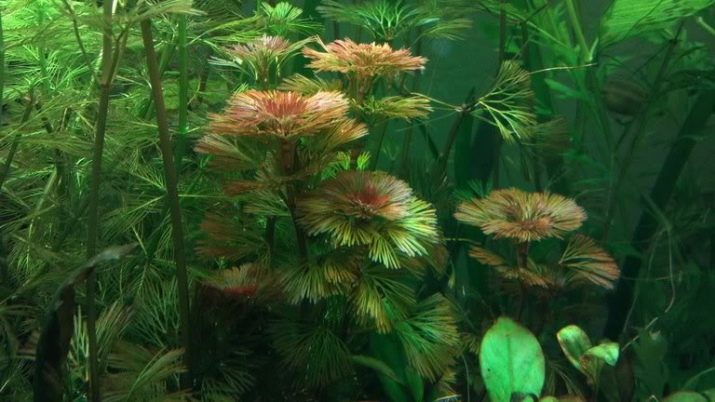
Growing conditions
The plant continues its growth and development throughout the year; in general, the underwater herringbone will be undemanding to the conditions of keeping. To ensure the comfortable coexistence of such a plant with aquatic inhabitants, it is worth maintaining the water temperature in the range from + 18 ° C to + 28 ° C.
With regard to acidity, the optimal indicator should be in the range of 6-8 pH. But if it is impossible to provide such an environment for the kabomba due to certain conditions, it will be possible to accustom it to a harder liquid, but then you should be prepared for the culture to grow much slower, in addition, the needle leaves will also be smaller in length ...
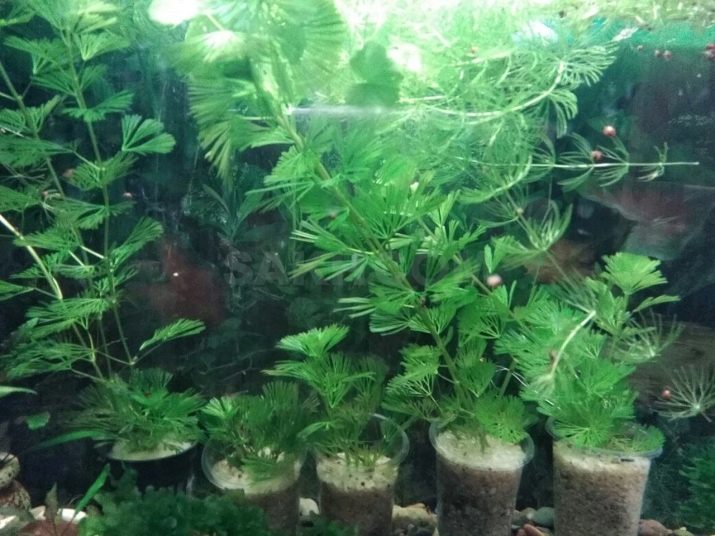
Like other aquatic inhabitants, the plant can develop various ailments. If you neglect the purity of the water in the aquarium, various particles of debris will settle on the kabomba in a cloudy tank, so the attractiveness of the ornamental culture will be significantly affected.
Changing the water in the container should be carried out regularly, and old leaves of the culture should also be removed. In all its glory, the kabomba can appear in glass tanks only if it is provided with good lighting. It is possible to determine that she lacks light by the elongated structure, as well as the faded color of the stems and leaves, they may even turn yellow. In order for the culture to grow well and correctly, the lighting must be combined, that is, natural and artificial light must enter the aquarium, but without direct ultraviolet rays, especially at noon.

Typically, aquarists use fluorescent lamps in kabomba tanks, the power of which will vary from 0.4-0.5 W / L with continuous operation for at least 8-12 hours a day.

Since the ornamental crop has a developed root system, it will need to provide a nutritious substrate for the aquarium. In order for the delicate roots to harden well, it is best to use pebbles or fine sand as a substrate for the bottom. If the raw material is large, creeping roots will develop at times worse.
The culture will not need additional feeding, because it is able to receive the missing substances from fresh water and feed, which the inhabitants of home aquariums will eat.
In winter, old shoots can rot at the kabomba, which, after separation, usually float to the surface.
However, there is no need to remove them from the tank, some must remain on the surface until the arrival of spring. During this period, leaf sinuses and young roots will begin to develop on them, if you separate such a part from the shoot, and then root it at the bottom, you can easily get a new decorative culture.
How to plant correctly?
In general, planting a plant will not cause any difficulties, even for an inexperienced aquarist.To decorate your tank with a kabomba, you just need to place the bush in the substrate at the bottom, additionally tamping the soil.

To stimulate the new crop to grow, it is worth pruning the top of the algae, so the new plant will have much more bushy shoots.
Excessive deepening in the ground should be avoided, since such planting options can lead to decay of the root system. To fix the kabomba in a new place, you can press it down with a decorative stone or snag from the aquarium for a while.
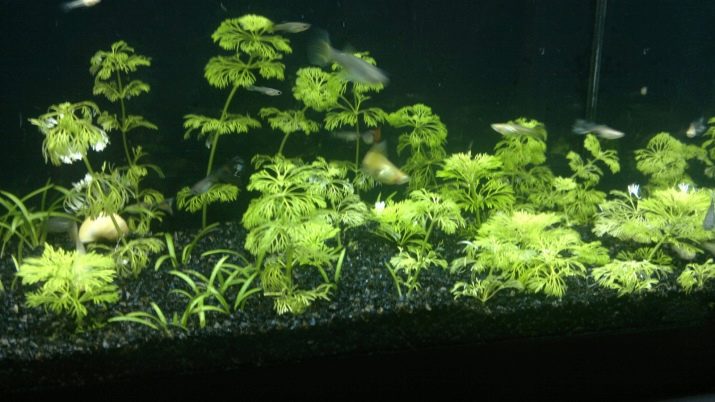
Reproduction
In conditions of closed tanks, an ornamental plant is usually propagated by cuttings of the main stem or rhizomes. If only the stem is cut, there should be at least small roots on it. If you root such a bush in the chosen place, it will begin to increase in size rather quickly.
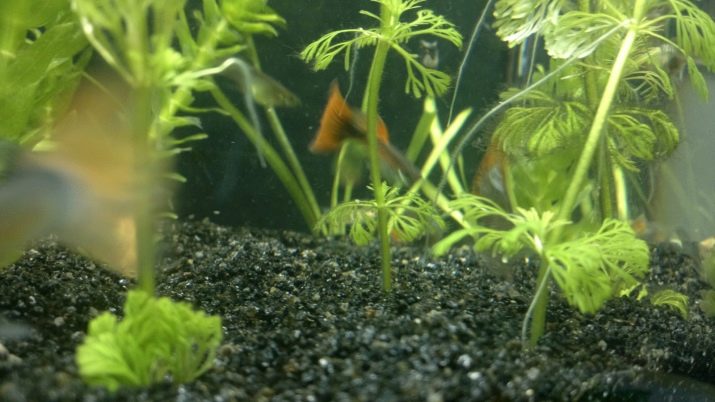
In addition, kabomba can be propagated using stems with several whorls of leaves. However, this option will not allow you to get a new decorative culture very quickly. For beginner aquarists who want to independently obtain a new ornamental plant, it is recommended to use the lower part with small roots or the apical cutting as cuttings. As practice shows, intermediate parts take root very slowly and not always successfully.
For the varieties of kabomba, see below.








